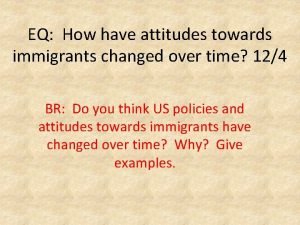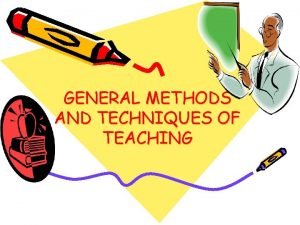Attitudes Towards Science and Science Teaching Understanding How

- Slides: 1

Attitudes Towards Science and Science Teaching – Understanding How Coursework and Practicum Affect Preservice Elementary Teachers Dr. Victoria Rosin and Elizabeth Scott | Department of Education Studies ABSTRACT METHODS The aim of the project is to find out whether UWEC’s elementary science methods course and local in-school (practicum) placement affect university preservice teachers’ attitudes towards science and science teaching. Researchers have indicated that elementary preservice teachers struggle with negative attitudes towards science and science teaching (Appleton, 2002; Watters & Ginns, 2000; Yates & Goodrum, 1990). A way to improve preservice teacher outcomes for teaching science is to provide positive teaching experiences with science (Cantrell, Young, & Moore, 2003; Ginns & Watters, 1999; Kenny, 2010). This study proposes to use an online survey and semi-structured interviews to investigate preservice teachers’ attitudes towards science and science teaching after completing the science methods course and in-school practicum. The anonymous online survey will gather general information about their science attitudes before and after the course. The survey will also assess how comfortable they are with teaching science in their practicum. By conducting semi-structured interviews with the preservice teachers, the desire is to gather details about whether their science attitudes are impacted positively, negatively, or not at all. The goal of this research is to be able to evaluate whether the two components are in alignment when preparing preservice teachers to teach science. FRAMEWORK INTRODUCTION As a professor of a science methods course at UW Eau Claire, Dr. Rosin noticed that many preservice teachers commented on the negative experiences they had, and negative attitudes they held, towards science. This is concerning because as future elementary and middle school teachers, research has indicated these attitudes could affect how much science is taught in their future classrooms (Palmer, 2002). The purpose of this research project is to gather information on the attitudes of preservice teachers towards science and science teaching, pre and post science methods course and practicum experience. A comparison of the results will check for any trends as to how the preservice teachers’ attitudes have changed positively, negatively, or not at all. Through this comparison, the findings could potentially assist in aligning the methods course to what occurs during the practicum teaching. To develop both a general and detailed picture of preservice teachers’ science and science teaching attitudes, a mixed methods framework will be used. Mixed methods is a study design in which the researchers collect and analyze data by integrating and drawing inferences of the findings using quantitative as well as qualitative methods (Teddlie & Tashakkori, 2006). A quantitative online survey and qualitative semistructured interviews are planned. ONLINE SURVEY The majority of the data collected will come from an anonymous online survey. This survey will be sent to all preservice teachers enrolled in the science methods course (ES 308). The first survey notice will be sent out the last week of practicum. The second survey notice will be sent out after their completion of the practicum. The intent of the survey questions is to get a broad overview of the preservice teachers’ attitudes towards science and science teaching, and how the information taught in the science methods course aligns, or not, with the practicum experience. The survey consists of 10 questions that focus on the topics listed below: • • Attitudes towards science before and after ES 308. Attitudes towards science teaching before and after ES 308. Ability to observe and teach science during practicum. Whether the science pedagogy taught in ES 308 is the pedagogy observed/used during practicum. The survey questions will use a 5 -point Likert scale of: Excellent, Good, Neutral, Fair, and Poor. There will also be a text box to allow the preservice teachers to elaborate on their rating. Descriptive summary statistics will be run on each term and other statistical analyses used between terms. Photo by startupstockphotos. com Creative Commons Zero License. DISCUSSION From previous informal discussions with preservice teachers that Dr. Rosin has, it is expected to see that a majority of the preservice teachers will hold negative attitudes towards science and science teaching. By investigating what, if anything, happens to these attitudes during the course, the findings have the potential to improve the experience for future preservice teachers. It is also anticipated that the findings of the practicum experience will verify or negate whether the pedagogy used in the practicum aligns with the pedagogy taught in the science methods course. The findings will also inform whether preservice teachers are able to both observe science being taught by experienced professionals and are able to experience teaching science themselves. REFERENCES Appleton, K. (2002). Science activities that work: Perceptions of primary school teachers. Research in Science Education, 32(3), 393 -410. doi: 10. 1023/A: 1020878121184 SEMI-STRUCTURED INTERVIEWS Photo by NEC Corporation of America Creative Commons Attribution License. PARTICIPANTS Participants will be sought from individuals enrolled in the science methods course (ES 308) during Fall 2016, Spring 2017 and Fall 2017. An email note will invite individuals to participate in the online survey. A second email note will again invite participation in the online survey and request volunteers for the semi-structured interviews. It is not expected to have full participation by each semester’s cohort. It is desired to have 75 -100 total participants in the online survey and 3 -6 interviewees. All participants will be juniors or seniors who are full time elementary education students at UWEC and are from Wisconsin and surrounding states. The semi-structured interviews will be used to develop depth in the data gathered from the online survey. Like the online survey, the questions being asked are intended to gather information on the preservice teachers’ attitudes towards science, science teaching, and how the information taught in the science methods course aligns with the pedagogy developed during practicum. While the questions are similar, the interview allows for the preservice teachers to elaborate on their answers and provide more specific responses. Semi-structured interviews are 11 questions in length and will be conducted face-to -face or electronically (i. e. Skype) by the student researcher. Interviews will be analyzed using analytical induction. Analytic induction entails deliberately searching for evidence that confirms and/or disconfirms the ideas/themes that emerge from the body of collected data (Erickson, 1986). Cantrell, P. , Young, S. , & Moore, A. (2003). Factors affecting science teaching efficacy of preservice elementary teachers. Journal of Science Teacher Education, 14(3), 177 - 192. doi: 10. 1023/A: 1025974417256 Erickson, F. (1986). Qualitative methods in research on teaching. In M. Wittrock (Ed. ), Handbook of research on teaching (3 rd ed. , pp. 119 -161). New York: Macmillian. Ginns, I. , & Watters, J. (1999). Beginning elementary school teachers and the effective teaching of science. Journal of Science Teacher Education, 10(4), 287 -313. doi: 10. 1023/A: 1009442125203 Kenny, J. (2010). Preparing pre-service primary teachers to teach primary science: A partnership-based approach. International Journal of Science Education, 32(10), 1267 -1288. doi: 10. 1080/09500690902977994 Palmer, D. (2002). Factors contributing to attitude exchange amongst preservice elementary teachers. Science Education, 86(1), 122 -138. doi: 10. 1002/sce. 10007 Teddlie, C. , & Tashakkori, A. (2006). A general typology of research designs featuring mixed methods. Research in the Schools, 13(1), 12 -28. Retrieved from http: //msera. org/Rits_131/Teddlie_Tashakkori_131. pdf Watters, J. , & Ginns, I. (2000). Developing motivation to teach elementary science: Effect of collaborative and authentic learning practices in preservice education. Journal of Science Teacher Education, 11(4), 301 -321. doi: 10. 1023/A: 1009429131064 Yates, S. , & Goodrum, D. (1990). How confident are primary school teachers in teaching science? Research in Science Education, 20(1), 300 -305. doi: 10. 1007/BF 02620506 We thank the Office of Research and Sponsored Programs for supporting this research, and Learning & Technology Services for printing this poster.

